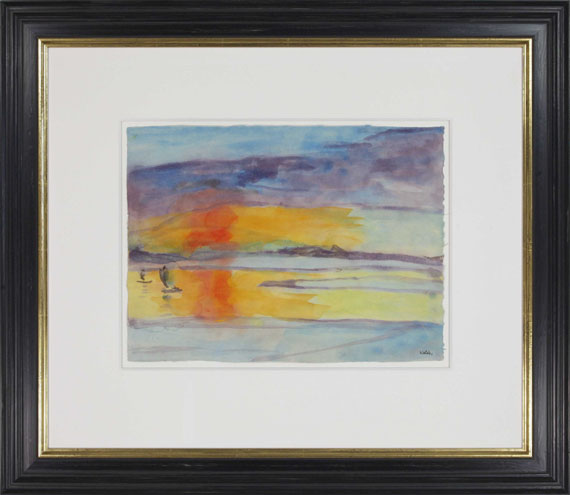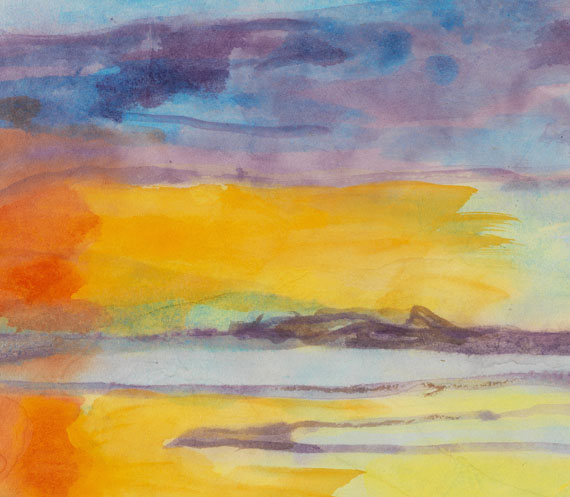216
Sonnenuntergang mit zwei Seglern, 1940.
Watercolor
Estimation:
€ 120,000 / $ 132,000 Résultat:
€ 225,000 / $ 247,500 ( frais d'adjudication compris)
Sonnenuntergang mit zwei Seglern. 1940s.
Watercolor.
Signed in lower right. On Japon. 34.8 x 46.8 cm (13.7 x 18.4 in), the full sheet.
• Striking account of a moment in an explosion of bright colors.
• Strongly contrasting color fields determine the dynamic expression of the picture.
• With the watercolor Nolde found a technique in line with his conception of the nature of painting and which enabled him to render the sensation of nature directly in form and colors.
Accompanied by a photo expertise isued by Prof. Dr. Manfred Reuther, then head of Foundation Seebüll Ada and Emil Nolde, from January 24, 2005.
PROVENANCE: Private collection Southern Germany (family-owned over several generations.
Private collection Northern Germany (since 2008).
"My home was like in a fairy tale, my childhood home in the flat lands, my land, with thousands of larks jubilating in the skies, my wonderland between the seas."
Emil Nolde
Watercolor.
Signed in lower right. On Japon. 34.8 x 46.8 cm (13.7 x 18.4 in), the full sheet.
• Striking account of a moment in an explosion of bright colors.
• Strongly contrasting color fields determine the dynamic expression of the picture.
• With the watercolor Nolde found a technique in line with his conception of the nature of painting and which enabled him to render the sensation of nature directly in form and colors.
Accompanied by a photo expertise isued by Prof. Dr. Manfred Reuther, then head of Foundation Seebüll Ada and Emil Nolde, from January 24, 2005.
PROVENANCE: Private collection Southern Germany (family-owned over several generations.
Private collection Northern Germany (since 2008).
"My home was like in a fairy tale, my childhood home in the flat lands, my land, with thousands of larks jubilating in the skies, my wonderland between the seas."
Emil Nolde
In 1867 Emil was born the sixth child of the Hansen family on the border to Denmark. As a young artist he gave up his birthname and named himself after the small village of Nolde, not far from Seebüll, where he was born. This shows his deeply felt connection to this piece of land, which became an inexhaustible source of inspiration for his work throughout his entire life. Even though Emil Nolde and his wife Ada did a lot of travelling, they went on a South Seas expedition in 1913/14 and usually spent the winter months in Berlin, they would always return to their home on the North Sea coast. After a long search, the couple found a piece of land with a farmhouse in Seebüll, where their new home was built according to the artist's plans between 1927 and 1937 based. Today the premises house the Ada and Emil Nolde Foundation. In the difficult years from 1937 and during the war, Seebüll was Nolde's place of refuge and the place where his late work, which had a focus on the watercolor technique, came into existence. As of 1904 Nolde found his real means of expression: color, which should unfold its spontaneous creative potential as little influenced as possible. "In painting, I always wanted the colors to have the same logical effect on the canvas through me as a painter as nature itself creates its structure .. like the flower blossoms in the rays of the sun." (Emil Nolde, quote from: Ex. cat. Emil Nolde. Aquarelle aus den Jahren 1894-1956, Kunstverein Hamburg, February 11-27, 1967, no p.). To Nolde the watercolor technique correlates most to the nature of painting and has the ability to directly translate the experience of nature into form and color. The vast marshland that surrounds Nolde's residence became the destination of his explorations. Its scant nature, solely inspired by weather phenomena offered Nolde a subject that Nolde interprets with his own emphasis. The result is a world of exuberant colors, rendered on the paper in his inimitable watercolor technique just the way the artist perceives them. This way Nolde gives a landscape that is simply flat and gray-green, devoid of any visual excesses, hitherto unknown colors. It is the changing lighting moods of a wide boundless sky that Nolde captures in order to combine them and form a symbiosis of closeness to nature and deliberate abstraction. It is not about reality, but the sensation of reality. The twilight in the north is a true orgy of colors, which Nolde was able to capture in masterly manner even under the time pressure that the rapidly changing lighting moods naturally bring with them. He translates the tension and intensity of the moment into color and captures the moment for eternity. [SM].
216
Sonnenuntergang mit zwei Seglern, 1940.
Watercolor
Estimation:
€ 120,000 / $ 132,000 Résultat:
€ 225,000 / $ 247,500 ( frais d'adjudication compris)




 Lot 216
Lot 216 
